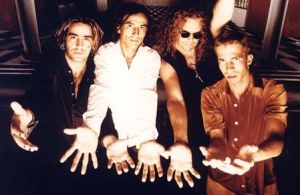Rock
Rock music is a loosely defined genre of popular music that entered the mainstream in the mid 1950s. It has its roots in 1940s and 1950s rhythm and blues, country music and other influences. In addition, rock music drew on a number of other musical influences, including folk music, jazz, and classical music.The sound of rock often revolves around the electric guitar or acoustic guitar, and it uses a strong back beat laid down by a rhythm section of electric bass guitar, drums, and keyboard instruments such as organ, piano, or, since the 1970s, synthesizers. Along with the guitar or keyboards, saxophone and blues-style harmonica are sometimes used as soloing instruments. In its "purest form", it "has three chords, a strong, insistent back beat, and a catchy melody."[1]In the late 1960s and early 1970s, rock music developed different subgenres. When it was blended with folk music it created folk rock, with
blues to create blues-rock and with jazz, to create jazz-rock fusion. In the 1970s, rock incorporated influences from soul, funk, and latin music. Also in the 1970s, rock developed a number of subgenres, such as soft rock, glam rock, heavy metal, hard rock, progressive rock, and punk rock. Rock subgenres that emerged in the 1980s included New Wave, hardcore punk and alternative rock. In the 1990s, rock subgenres included grunge, Britpop, indie rock, and nu metal.A group of musicians specializing in rock music is called a rock band or rock group. Many rock groups consist of an electric guitarist, lead singer,
bass guitarist, and a drummer, forming a quartet. Some groups omit one or more of these roles and/or utilize a lead singer who plays an instrument while singing, sometimes forming a trio or duo; others include additional musicians such as one or two rhythm guitarists and/or a keyboardist. More rarely, groups also utilize stringed instruments such as violins or cellos, or horn sections of saxophones, trumpets or trombones

Mexican pop-rockers Maná are considered the kings of Latino
rock and have a huge following in the United States. Their
sound is comprised of hard rock, more mellow pop sounds, and
hints of calypso and reggae. Their lush sound captured the first
annual Latin Grammy Awards in fall 2000, for Maná won the award
for Best Pop Performance by a Duo or Group with Vocal for "Se Me
Olvido Otra Vez" from their 1999 release MTV Unplugged. 2002's
Revolución de Amor featured Carlos Santana and Rubén Blades as guest
performers. ~ Sandra Brennan, All Music Guide

At the dawn of the new millennium, Enrique Iglesias was the best-selling Latin recording artist in the world.
The son of multi-million-selling singer Julio Iglesias, Enrique was born in Madrid, Spain, where he lived with
his mother, his brother Julio, and his sister Chabeli. In 1982, his mother sent them to live in Miami with their
father. While there, Enrique was exposed to three different cultures and musical influences: Hispanic, European,
and American. Iglesias' own career started when he was still attending Gulliver Private School, a very prestigious
school in Miami. He made his singing debut in a production of Hello, Dolly, after which he began practicing his singing
without his parents knowing. After a year studying business at the University of Miami, he decided to follow his passion
for music. In 1995, he sang in person for his soon-to-be manager, who at Iglesias' insistence of not wanting to use his
family name, first shopped his demos as an unknown Central American singer named Enrique Martinez. It wasn't until he earned
a record deal with Fonovisa that Enrique told his father and mother of his aspirations. Then he flew to Toronto, where no one
knew him and he could concentrate just on music, to record for five months. That first album, Enrique Iglesias (1995),
sold more than a million copies in three months (it earned him his first gold record in Portugal in a mere seven days)
and to date has sold more than six million worldwide. The second album, Vivir (1997), enjoyed global sales of more than
five million discs and launched his first world tour, backed by sidemen for Elton John, Bruce Springsteen, and Billy Joel.
In a mere three years, Iglesias had sold more than 17 million Spanish-language albums, more than anyone else during that
period. (The U.S. was his biggest market.) He also won the 1996 Grammy for Best Latin Performer, 1996's Billboard Artist of
the Year, Billboard's Album of the Year for Vivir, two American Music Awards, a World Music Award, eight Premio Lo Nuestro
awards, two ACE Performer of the Year awards, and ASCAP prizes for Best Composer of 1996 and 1997, in addition to countless
accolades around the world. With 1998's Cosas del Amor, Iglesias moved to more mature content; his earlier material had been
written when he was 17 years old. Then came Enrique, his first Interscope album and first in English. It achieved gold or platinum
status in 32 countries and brought his global album sales to a total of more than 23 million. In 2001 he released the follow-up,
Escape. Iglesias alternated Spanish- and English-language albums during the next two years, first offering the ballad collection
Quiz?s in 2002, then the mainstream English record 7 in 2003. Four years later the single "Do You Know (The Ping Pong Song)"
announced the coming of his 2007 album Insomniac. ~ Ed Nimmervoll, All Music Guide

Mexican singer/songwriter Julieta Venegas established herself initially
as a cutting-edge Latin alternative artist during the late '90s, before
her career shifted direction significantly with her third album, Sí (2003),
a broadly appealing pop/rock effort graced with genuine hits, including a couple
chart-toppers. In the wake of her 2003 breakthrough, Venegas didn't look back.
Her next album, Limón y Sal (2006), was just as broadly appealing as its predecessor,
and it was an even bigger hit, spawning several major hits and finding success in
western Europe as well as the Americas. Moreover, Venegas was as acclaimed as she
was popular, customarily earning the praise of critics and winning awards, including
numerous Grammys. Her musical abilities were sometimes overlooked, for in addition to
writing and singing her own songs, she plays numerous instruments, including guitar,
accordion, and keyboard. Venegas also made a name for herself as a collaborator, writing
songs for and performing with a range of Latin artists, from Paulina Rubio and Mala Rodríguez
to Miguel Bosé and Los Tigres del Norte.

click herer to see more about the artists
pictures/music/
Back



